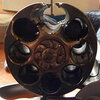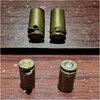I shot my .45 acp yesterday for the first time in a month or two. I've been using same batch of reloads for years without issue.
Anyhow, first shot....face full of powder and too much recoil. I drop the mag and rack the slide. Magazine bottom is gone along with spring and follower. Rear of case is blown out from 4 to 8 O'clock. I thought primer had a light strike but now I see it is protruding out some.
I had never experienced a double charge so I was thinking more along the line of," how did my gun discharge when it wasn't fully in battery"? Stupidly (In retrospect), I continued to shoot and the gun ran fine.
So, what do you guys think happened? What should I be inspecting on the gun (1983 SA mil spec)?
FWIW load was either (cast lead Valiant) 185 grain SWC over 4.2 grains of WST or 160 grain SWC over 4.5 of BE.
I'm more shook up about it now than yesterday, so please forgive my scatter brain post.
Anyhow, first shot....face full of powder and too much recoil. I drop the mag and rack the slide. Magazine bottom is gone along with spring and follower. Rear of case is blown out from 4 to 8 O'clock. I thought primer had a light strike but now I see it is protruding out some.
I had never experienced a double charge so I was thinking more along the line of," how did my gun discharge when it wasn't fully in battery"? Stupidly (In retrospect), I continued to shoot and the gun ran fine.
So, what do you guys think happened? What should I be inspecting on the gun (1983 SA mil spec)?
FWIW load was either (cast lead Valiant) 185 grain SWC over 4.2 grains of WST or 160 grain SWC over 4.5 of BE.
I'm more shook up about it now than yesterday, so please forgive my scatter brain post.





